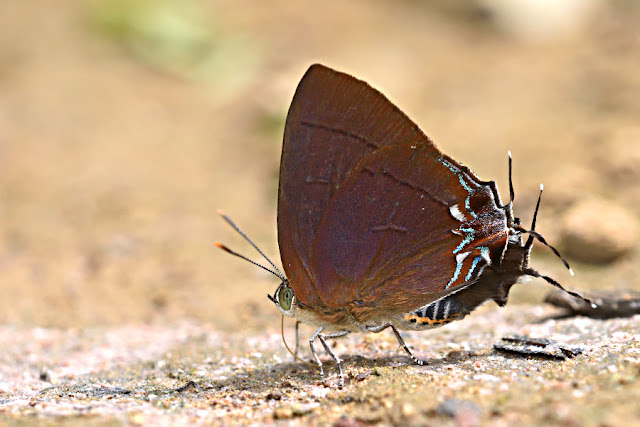This time, there were not many Lycaenids in terms of number of species and quantities. As usual, most of the puddling shots were taken at Chiangdao.
Let me begin with a small lycaenid that blended very well with the soil - this is the Barred Lineblue (Prosotas aluta coelestis) which was puddling on the behind the worker's quarter.
This looks like the Bhutea Lineblue (Prosotas bhutea) which seemed to be less common as I didn't get to spot it on other days when we were at Chiangdao.
Most of the time,the White Four Lineblue (Nacaduba angusta albida) was found puddling. This species reminded me of the late uncle Sunny - he spotted and shot the subspecies kerriana some years ago at Telok Blangah Hill Park.
This looks like the Rounded Sixline Blue (Nacaduba berenice) climbing over a rock.The Dingy Lineblue (Petrelaea dana dana) does not seem to be common too - I only spotted it once.
Look at the following few Hedge Blue shots, you will know that it is very challenging to identify them accurately. This is The Plain Hedge Blue (Celastrina lavendularis).
The Hedge Cupid (Bothrinia chennelli celastroides)It looks like The Swinhoe's Hedge Blue (Monodontides musina musinoides).
The Common Hedge Blue (Acytolepis puspa ).
I constantly looked out for different shots. When this Common Peirrot (Castalius rosimon rosimon) was feeding on flowers, I could not wait to take a few shots.
The uppersides of another Common Peirrot when it was sunbathing on a late afternoon.
The Forest Quaker (Pithecops corvus corvus) was quite small but it could be very alert and active.
The Indian Cupid (Everes lacturnus) was having a short break on a leaf.
This is an Elbowed Pierrot (Caleta elna noliteia ) - a very common species on the Chiangdao puddling ground.
A close cousin to C. elna, the Straight Peirrot (Caleta roxus Roxana) was abundant too.This is an Elbowed Pierrot (Caleta elna noliteia ) - a very common species on the Chiangdao puddling ground.
This is the Banded Peirrot (Discolampa ethion ethion). We could easily mistake it for the Straight Peirrot due to their close resemblance with each other.
The Blue Leaf Blue (Amblypodia narada taooana) was found amongst some glasses at Doi Ithanon.This Long-banded Silver Line (Cigaritis lohita himalayanus) was puddling on the ground under the hot sun.
When this Orchid Tit (Hypolycaena othona othona) changed its perch a few times before I could snap a few quick shots.
The Common Yamfly (Loxura atymnus) presented a nice and elegant perch on a blade of grass.
Some family of lycaenids have four or more tails. This is a Chocolate Royal (Remelana jangala ravata).
Long-tailed lycaenids are simply amazing to many butterfly photographers and they cannot be found in some places such as Hong Kong. We spotted a few of them.We saw the Common Imperial (Cheritra freja) on two days at Chiangdao.
At the same location as the Common Imperial, the Blue Imperial (Ticherra acte acte) attracted more attention amongst us.
The Fluffy Tit (Hypolycaena amasa) was at first puddling on the ground. It decided to rest on a leaf once it had enough mineral solution uptake from the ground.
It opened its wings fully for an afternoon sun bathing.
The Angled Sunbean (Curetis acuta dentata) appeared to be common as I encountered it at two different locations.
This is another species, the Bright Sunbeam (Curetis bulis).I was lucky to be able to shoot something new this trip - the Blue Brilliant (Simiskina phalia potina)
The upperside shot confirms that this is a female.
Another gem, the Common Gem (Poritia hewitsoni) was shot at Doi Suthep.
The Common Purple Sapphire (Heliophorus epicles) is an attractive and common butterfly in northern Thailand.
An upperside shot of a female and a male.To be continued.


































No comments:
Post a Comment